Audio Design Desk — a New Paradigm for Audio Post-Production
Article Content

I am a huge fan of innovative startups in the music business and one that caught my eye at NAMM this year was Audio Design Desk. It’s a new intelligent approach for audio post-production that promises blazing workflow speeds for adding sound effects, foley, ambience, and music to a moving image. One part sampler, one part DAW, one part sound library – this software has unique hybrid functionality that sets it apart from any other software solution out there.
Typical in a post-production workflow is the setting of markers at key points in a video where sounds need to be placed, a process referred to as spotting. Markers are labeled with descriptive names, and comments regarding the nature of the sounds to be used are entered. Afterward, sounds are created and/or culled from an existing library and meticulously placed at the sync points. To audition alternate sounds for the same location, playlists or alternate tracks may be used. Sounds may require time expansion or compression, fades in/out, etc. The process can be slow and painstaking.
Enter Audio Design Desk, referred to as add.app. This stand-alone program comes with access to 20,000 sounds: Ambience, Foley, Footsteps, Music stems, Sound Design and Sound Effects. Categories have two subfolders: Elements and Stems, where Elements are typically shorter and Stems can contain several combined elements (e.g. a single footstep vs. a sequence of steps).
Sounds within a category will have several variations. For example in the Demo pack, the subfolder Footsteps/Element/Concrete/Sneaker includes 10 variations of the sound. You can program a key trigger to randomly access that set of samples. Downloading the available sound packs will give you access to a ton of ready-to-use content, all searchable from within the browser using various tags.

The video is imported into the program and is displayed in a large detachable window above the timeline. As the movie plays, the user hits the trigger key for a particular sound category to set markers at sync points. Stopping the session will result in those sounds being chosen randomly from the category and placed in autogenerated tracks at the sync points.
If you are not happy with the sounds chosen you can swap them with a simple key command and they will be replaced with alternative options. It’s quite magical!
Specific region groups or individual regions can be swapped repeatedly and at blazing speed when compared to importing or dragging and dropping one sound at a time. Each sound has embedded sync point data so that even if there are differences in duration, the samples line up with the marker.
You can export a cue sheet from a user-selected range on the timeline that includes SMPTE I/O, Filename, and sound source or composer. Content sources include several thousand sounds from sound designer Sam Music and other sound designers and composers including the company founder, Gabe Cowan.
You can also import your own audio or libraries using the ADD Importer where you can update metadata and sync marker points.

I recall watching an interview with sound designer, Randy Thom regarding his work on Forest Gump. He describes how the ping-pong scene sequence was created with individually recorded ping-pong hits being cut to sync throughout. Audio Design Desk might have been the perfect tool to dramatically expedite that process.
In addition to sound and Foley effects, the Audio Design Desk library includes precomposed music stems, that can be placed, arranged, and swapped with lightning speed. The swapping or Replace feature for music and effects is really astounding. The ability to select dozens of regions on multiple tracks and replace them with similar sounds instantly is outrageously cool.
Under the triggers menu you’ll find key triggers for commonly used sonic gestures:

As mentioned, the Replace command will replace existing regions with similar sounds. But you can also refine or change the nature of the replacement sounds by adjusting functions in the Replace matrix using tags and two descriptive continuums – Intensity and Complexity. This sort of control is perfect for experimenting with various musical approaches of individual elements of a musical texture.

Export formats for the session include AAF, XML and multichannel .wav enabling a smooth workflow between other DAWs or video editing software. You can also bounce to .aif, .wav, .caf, and .m4a files.
Audio Design Desk is offered as a subscription model with three basic tiers:

Visit the website for Product Demo Videos.
Conclusions
The audio post-production industry is a deadline-driven sector where speed is essential and highly-prized by both clients and post-production engineers. Audio Design Desk will never replace a traditional Foley pit or a sound design crew for productions with deep pockets. But there are definitely many situations in which a busy post-production house or freelance engineers could make great use of the unique functionality and speed add.app has to offer.
I don’t see it replacing Pro Tools or other DAWs in terms of mixing. The familiarity and accessibility of traditional audio work stations are well-entrenched and established. But this application can offer the ability to generate SFX, Foley and music stems with astounding speed and that alone is worth the price of admission.
The Replace function is truly remarkable and I can envision using this capability along with my personal precomposed sound content to write new material with or without an image. As I write this article, Audio Design Desk is just one month old and I cannot wait to see how the future unfolds for this phenomenal and intelligent application. Consider the game … changed!
Interview
Gabe Cowan, the founder of the company, agreed to answer a few questions about the origins of Audio Design Desk and what’s in store for the future.
Philip Mantione: Can you briefly talk about your background and the origins of the company?
Gabe Cowan: I was lucky enough to get signed to Geffen Records right out of high school. I received a couple of platinum records before scoring a film for Roger Corman. Roger suggested I start making films so I got my master’s degree in film directing. I produced over 20 features and because I came from music, I’d always been obsessed with the sound of my films. A few years ago, I was editing one of our trailers and struggling with finding the right sounds and I thought ‘This process is unbelievably inefficient.’ I realized that the reason the process is so time-consuming is that nobody had built an application from the ground up to connect audio to video. I sketched something out and that was the germ of the idea that became Audio Design Desk.
Meanwhile, my dear friend Sam Music, who had started the sound design company that produced sounds for Spider-Man, Rogue One, World War Z and tons of other trailers, was mastering his sounds at my studio. I pitched him the idea and he loved it.
We contacted Ryan Francesconi who we knew from college. Ryan is a genius musician and a genius programmer and when we explained the idea to him, he jumped in and we started on this massive journey.
PM: What are the main things Audio Design Desk can do that make it a unique solution for Audio Post Production?
GC: You can perform your sounds in real-time using the keys on your QWERTY keyboard, so placing something like footsteps is 80% faster than it is using today’s tools. But the power is also in the ability to replace sounds. Once your first draft is set, you can select your sounds and replace them with alternates in a single click — without losing sync. Hits, rises, drones, transitions, footsteps, ambiances — whatever you want. For me, this is a game-changer.
In terms of sound design, you can score your movie or advertisement by watching the video and clicking H for hit, R for rise, D for drone, and so on. Once your first draft is set, you can create entirely new compositions by telling the program you want more or less intense sounds or you want comedy or horror or action sounds and at the click of a button, you have an entirely new composition that is perfectly in sync with your film. It’s pretty amazing.
Real-time music selection works the same way — audition music and create selections in real-time.
If you want to swap out a sound, you can search for alternates by selecting the sound in the timeline and clicking a button.
If you want to place a sound that you’re not performing, you can drop what we call the “Magic Marker” in the timeline and search for any kind of audio right on the frame where you need it.
Our whole goal is to keep you inspired and to take the technology out of the equation so you can create without losing your momentum.
PM: What types of Post Production professionals would have the most use for add.app? In other words, is there a particular market you are targeting?
GC: Audio Design Desk is a professional tool, but it has the advantage of being extremely easy to use. Typically the barrier to entry with creative tools is extremely high. Pro Tools, Avid, Premiere, Photoshop … they’re amazing but they require a lot of training. With add.app, you can jump right in. It’s built for professionals and prosumers and it has all the professional tools you’d expect of a full-featured application — but my nine year old uses it to create cinema-quality sound too.
PM: With entrenched DAWs such as Pro Tools, Nuendo and now Reaper gaining ground, do you envision the application being used in conjunction with other DAWs? If so, can you describe a typical workflow?
GC: Absolutely. The workflow depends on who you are. If you’re an editor, throw your cut into add.app and turn around full sound in minutes instead of hours. Send an XML to Premiere or Final Cut or an AAF to Avid and all the sounds will populate your timeline in an instant. Having real sound while you’re editing can make an incredible difference.
When you’re done, send the final cut to a sound designer and they’ll bring the video into add.app and create their first pass in a day instead of a week.
Then export an AAF to Pro Tools and dig into your final mix or export a multichannel .wav to preserve all the tweaks you make in add.app. Audio Design Desk features a handy ‘organize tracks’ tool, so if users want to export stems and keep things organized, it does a lot of that work for you.
PM: Clearly the available sound packs used in add.app are one of its distinguishing benefits. Can you talk about how these differ from other sound libraries currently available? How can existing libraries be implemented in the add.app environment?
GC: Sam Music, whose sound designs are used in trailers for blockbuster Hollywood films, produced over 5,000 original sounds for Audio Design Desk — giving users access to the same quality sounds that have been used in prestigious industry works. We’ve built up an incredible team of sound designers, sound effects artists, and composers who are working every day to produce our next sound packs.
In addition to cultivating a library of sounds produced by the industry’s top talent, add.app features an intelligent importer that’s getting smarter all the time thanks to Machine Learning, where users can import thousands of sounds, which add.app then assigns what we call Sonic Intelligence — it’s part of what makes add.app so powerful.
PM: What was the reasoning behind a subscription model in terms of pricing?
GC: If you look at the market, buying an application like this and a sound library of 20,000 sounds would cost $7-8,000.00. We really wanted everyone to be able to afford Audio Design Desk so we came up with a model that’s flexible and affordable while allowing us to continue to innovate and expand on add.app’s capabilities — creating new possibilities for everyone who uses it.
PM: Can you talk specifically about the Artificial Intelligence and Machine Learning functionality under the hood?
GC: Sorry. That’s top secret. Hopefully, the user experience speaks for itself. I will say the AI is what makes Audio Design Desk so easy to use. It’s getting better all the time.
PM: Okay, it was worth a try. 🙂 Are there any new ideas being developed for future versions you’d like to mention?
GC: Absolutely. Everything from MIDI to more advanced automation to new ways of manipulating sounds. We have quite an incredible roadmap ahead.
PM: Any other comments you’d like to share?
GC: I just feel so lucky to have the application out in the world and to have gotten such positive feedback. Building something like this takes years and there are huge players out there with billions of dollars setting the bar of expectations for users. When we released add.app, we didn’t know what people would think. We set out to make an application that makes sound designer’s lives easier and that unlocks creativity in everyone. Thank you so much for taking the time to look at our program and for allowing me to talk about it.
Check out my other articles, reviews and interviews
Follow me on Twitter / Instagram / YouTube





